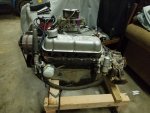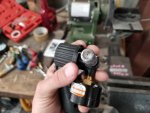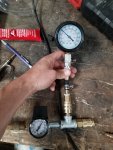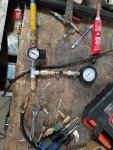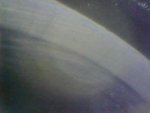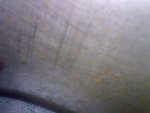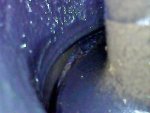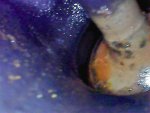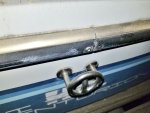Hey All!
Sorry for not updating at all last week, work got a bit crazy for me but I was able to put in a few hours in the afternoons and got some small progress done on the boat. So here we go!
I followed
boedekerj's advice and got a scope, pretty nifty little camera that was cheap and showed me exactly what I needed, I only looked in cylinders 2,3,4 out of curiosity, I still need to do my due diligence and do them all, but the image below shows pretty decent cross hatching (from my unprofessional optionion)

IMO; I would scope it to look for scoring in the cylinders before you put too much into it that block, man. Google search "borescope camera for android". they're cheap. If you take a peak in each of your cylinders (at bottom) make sure that you still see good and distinct cross-hatching and no hazing or vertical scoring. This happens sometimes if debris/corrosion get's into the cylinders and you rotate it. If the cross-hatching is gone or its scored or hazed, you're going to have a smoky-blue haze that never goes away.
next, I also got the engine out of the boat, I have more images on my camera but these are what I can pull from my phone. I built a basic engine "stand", although I am afraid to call it that since it doesn't do much more than keep it off the concrete and be on casters so I can move it around the garage. I had spaced the top 4x4 so that I could use the engine mounts to be more sturdy, but the oil pan is too low for that to actually work, whoops. But, it is serving its purpose until I can do my compression and leak test to see if a rebuild is necessary, in that case I will get an actual stand.
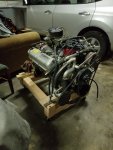
I used a small rotary wire brush and cleaned out the core (welsh) plug holes to be ready for the new plugs. I realize that this may be premature if I end up doing a rebuild on the engine, but I got excited to start putting something together rather than keep tearing things apart. So I got 3 of them in and then bashed my hand with the mini sledge I was using. Does anyone have a better way of getting new plugs in without being able to rotate the engine? I was using my axle socket and an extension in it reversed. It worked pretty well until I missed the extension, just an awkward angle and its tough to keep them all in line with each other.

Next we went back into deconstruction/destruction mode on the floor. Starboard was VERY soft and came up in fist sized pieces. Port was a bit better and I actually had to cut the glass off the wall and transom and got it all out in 1ish piece. Looks like the port was the original (or at least correctly rebuilt), and the starboard was a chop job with small pieces of plywood slopped together with CFM and TONS of screws. As Scott Danforth pointed out, my optimism for the stringers did not pay off and most of the screws I was able to pull out of the stringers by hand. Dont think thats how they are supposed to work haha. So, ouch.
I have images on my camera that I will try to get up in the next couple days of the stringers and deconstructed floor.
We got the foam out from under and cleaned up the boat a bit, but we are looking at having to take the cap off to get to the front portion of the hull. Any advice on getting the hull off of an inboard? I would guess that it is similar to an outboard, but my only reference is a Glastron project that JMink did. Huge fan of his videos, informational, and he has an awesome dry sense of humor that I appreciate.
https://www.youtube.com/playlist?list=PL3VcOAbbi5n1gEzUaZF3CiTJs4-21ol2d
My thought was to build a support for the hull so it doesn't sag out of shape, and then take off the rub rail and gently motivate the separation of the two. then build a frame to hold it up and pull the hull out from under it? This is my basic thoughts but I'm sure someone on here will have a better idea or reference I can look at.
Lots of words but hopefully it gives a good scope of where we are now and I can get some feedback on how to proceed which makes sense. I don't run a machine shop or rebuild for a living, so I understand not everything I do is perfect, but just trying to have some fun, learn a lot, and come out with a better boat than when I started. Cheers!























